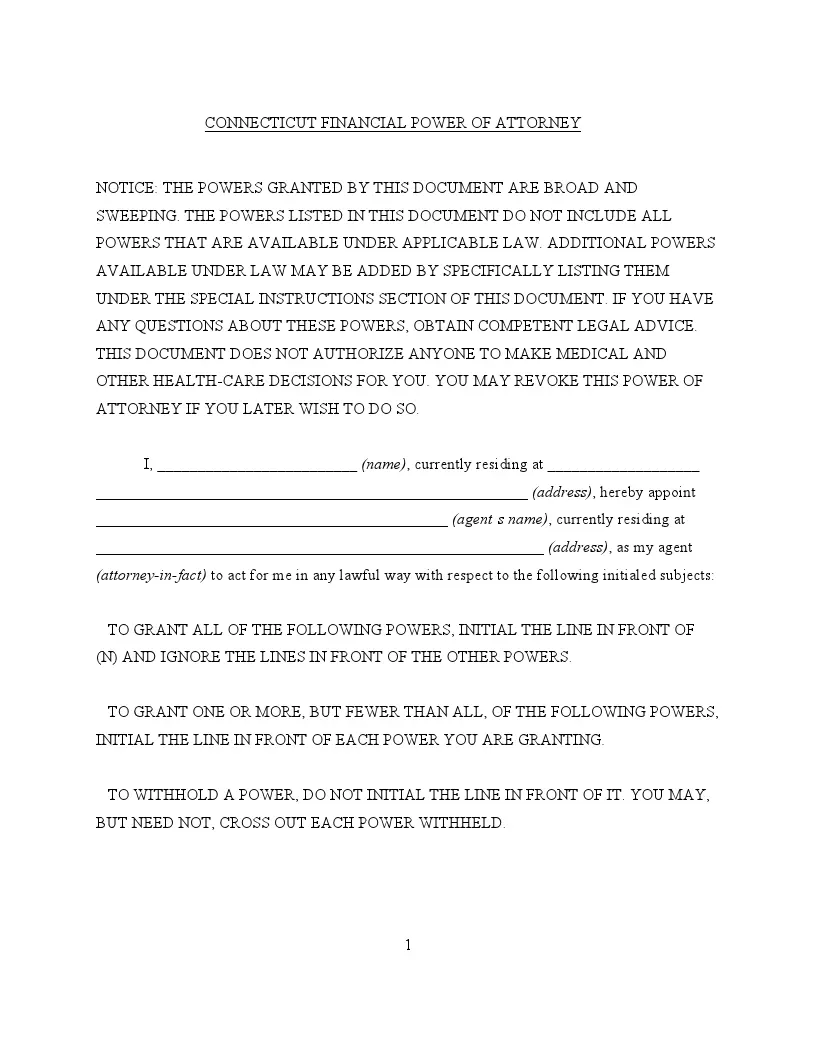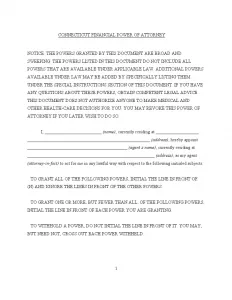Connecticut General Financial Power of Attorney Form
The Connecticut general financial power of attorney is a legal document that enables the “principal” to designate the “agent” or “attorney-in-fact” to manage their financial decisions and transactions. Unlike a limited power of attorney, which only grants powers for particular activities or under certain conditions, this form covers a broad range of actions regarding the principal’s assets and financial affairs.
The authority granted through a general power of attorney in Connecticut can include managing bank accounts, signing checks, buying or selling property, and handling investment decisions. However, it’s important to note that Connecticut’s general power of attorney is not “durable” by default. This means it does not remain in effect if the principal becomes incapacitated. In such cases, use other Connecticut power of attorney forms on our site.

Build Your Document
Answer a few simple questions to make your document in minutes
Save and Print
Save progress and finish on any device, download and print anytime
Sign and Use
Your valid, lawyer-approved document is ready
In Connecticut, the laws governing a general power of attorney are detailed in Chapter 15c of the Connecticut General Statutes (Sections 1-350 to 1-353b). The law defines a “power of attorney” as any written or recorded document that gives an agent the authority to act on behalf of the principal, irrespective of the terminology used. The legal requirements for this document in Connecticut include:
- A power of attorney must clearly define the extent of authority given to the agent.
- The document must be authenticated by a notary public and signed by two eligible witnesses.
- As provided in Section 1-350i, the principal retains the right to revoke the power of attorney at any time.
These provisions protect the principal’s interests while granting the agent broad authority to handle affairs as specified. Compliance with these statutes is critical for those drafting or executing a power of attorney in Connecticut.
Connecticut General Power of Attorney Form Details
| Document Name | Connecticut General Power of Attorney Form |
| Other Name | Connecticut Financial Power of Attorney |
| Relevant Laws | Connecticut General Statutes, Sections 1-350 to 1-353b |
| Avg. Time to Fill Out | 10 minutes |
| # of Fillable Fields | 41 |
| Available Formats | Adobe PDF |
Filling Out Connecticut General (Financial) POA Form
Completing a general power of attorney in Connecticut allows you to designate someone to handle various financial and legal matters on your behalf. Below is a detailed guide to help you fill out this form accurately and effectively.
1. Principal and Attorney-in-Fact Details
Start by entering your full name and address as the principal. Then, specify the person you are appointing as your attorney-in-fact by writing their full name and address. This person will have the authority to act on your behalf in various matters.
2. Define the Powers Granted
The form lists several categories of powers you can grant your attorney-in-fact, from real estate transactions to military benefits. You will need to:
- Read each category carefully.
- If you wish to grant a power, leave the box next to it unchecked.
- If you do not want to grant a specific power, strike through the text of that subdivision and initial in the box opposite to indicate your decision.
Consider each category thoughtfully, as these decisions will dictate the extent of control your attorney-in-fact will have.
3. Special Provisions and Limitations
This section allows you to include specific conditions or limitations to the powers granted. If you have particular wishes or detailed instructions about managing your affairs, document them here. Ensure that these stipulations conform to the requirements of the Connecticut law.
4. Execution of the Document
Once you have filled out the form and reviewed it for accuracy and completeness. Then, sign the document in the presence of two witnesses. Both witnesses must also sign and provide their addresses. Also, ensure that the form is notarized to validate its authenticity.
5. Handling of the Completed Form
After the form is properly signed and notarized:
- Provide a copy to your attorney-in-fact.
- Keep the original in a safe place.
- Consider giving copies to other relevant parties, such as your lawyer or financial advisor.
This power of attorney will become void if you become disabled or incompetent. If you wish to revoke the power of attorney at any time when you are competent, you must do so in writing and provide notice to your attorney-in-fact and any third parties who rely on the document.
